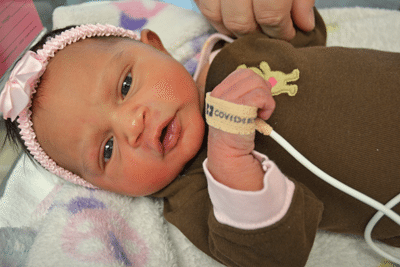UAMS Takes Leading Role in Newborn Heart Screening
| 
A noninvasive pulse oximeter attached to the right hand of Farrah Clark, a newborn at UAMS, ruled out any critical congenital heart defects.
Jan. 20, 2012 | The University of Arkansas for Medical Sciences (UAMS) has begun routine screenings for critical congenital heart defects in newborns and is leading the effort to teach other hospitals the screening method via telehealth.
At no additional cost to patients, UAMS this month began using a painless, noninvasive device that detects the first signs of the most serious heart problems. The device, called a pulse oximeter, is about the size of a Band Aid and is placed on a hand and a foot to measure
blood oxygen levels.
Critical congenital heart disease affects 1.8 of 1,000 newborns each year and causes up to 10 percent of infant deaths. UAMS, which delivers about 2,500 babies a year, will see about five newborns a year affected by a critical congenital heart defect as a result of the screening.
Critical congenital heart disease occurs when a structural abnormality causes blood to flow incorrectly through the heart and lungs, leading to decreased oxygen levels in the blood. Some congenital heart diseases can be detected before birth or through physical examination after delivery, but about 30 percent of newborns with a critical congenital heart defect may leave the hospital before being diagnosed.
Using interactive video communication (telehealth) and live video streaming on the Internet, UAMS faculty and Arkansas Children’s Hospital have partnered to teach the screening protocol to the 45 other Arkansas hospitals with labor and delivery units.
“The goal of the UAMS Medical Center Congenital Heart Disease Screening Program is simple, to ensure that infants with critical congenital heart disease are detected before they are discharged from the hospital,” said Robert Morrow, M.D., a pediatric cardiologist at UAMS and senior vice president for medical affairs at Arkansas Children’s Hospital.
The decision to begin the routine screenings was based on research of how to detect congenital heart disease using pulse oximetry. In 2011, a national workgroup of experts, including Morrow, developed a screening protocol based on the latest evidence and expert opinion.
The findings and recommendations from this workgroup were published in the Journal of American Academy of Pediatrics in November 2011; Strategies for Implementing Screening for Critical Congenital Heart Disease by Dr. Alex Kemper, et al.
The American Heart Association, American Academy of Pediatrics and American College of Cardiology also support newborn pulse oximetry screening for critical congenital heart disease.
“As a leader in health care and research in Arkansas, we at UAMS have an obligation and a commitment to advocate for universal critical congenital heart disease pulse oximetry screening,” Morrow said. “The Arkansas Legislature has not yet mandated this screening for all newborns, but a group of medical advocates and experts is working to make this a reality for all newborns delivered in Arkansas.”
UAMS is the state’s only comprehensive academic health center, with colleges of Medicine, Nursing, Pharmacy, Health Related Professions and Public Health; a graduate school; a hospital; a statewide network of regional centers; and seven institutes: the Winthrop P. Rockefeller Cancer Institute, the Jackson T. Stephens Spine & Neurosciences Institute, the Myeloma Institute for Research and Therapy, the Harvey & Bernice Jones Eye Institute, the Psychiatric Research Institute, the Donald W. Reynolds Institute on Aging and the Translational Research Institute. Named best Little Rock metropolitan area hospital by U.S. News & World Report, it is the only adult Level 1 trauma center in the state. UAMS has more than 2,800 students and 775 medical residents. It is the state’s largest public employer with more than 10,000 employees, including about 1,000 physicians and other professionals who provide care to patients at UAMS, Arkansas Children’s Hospital, the VA Medical Center and UAMS’ Area Health Education Centers throughout the state. Visit www.uams.edu or uamshealth.com.